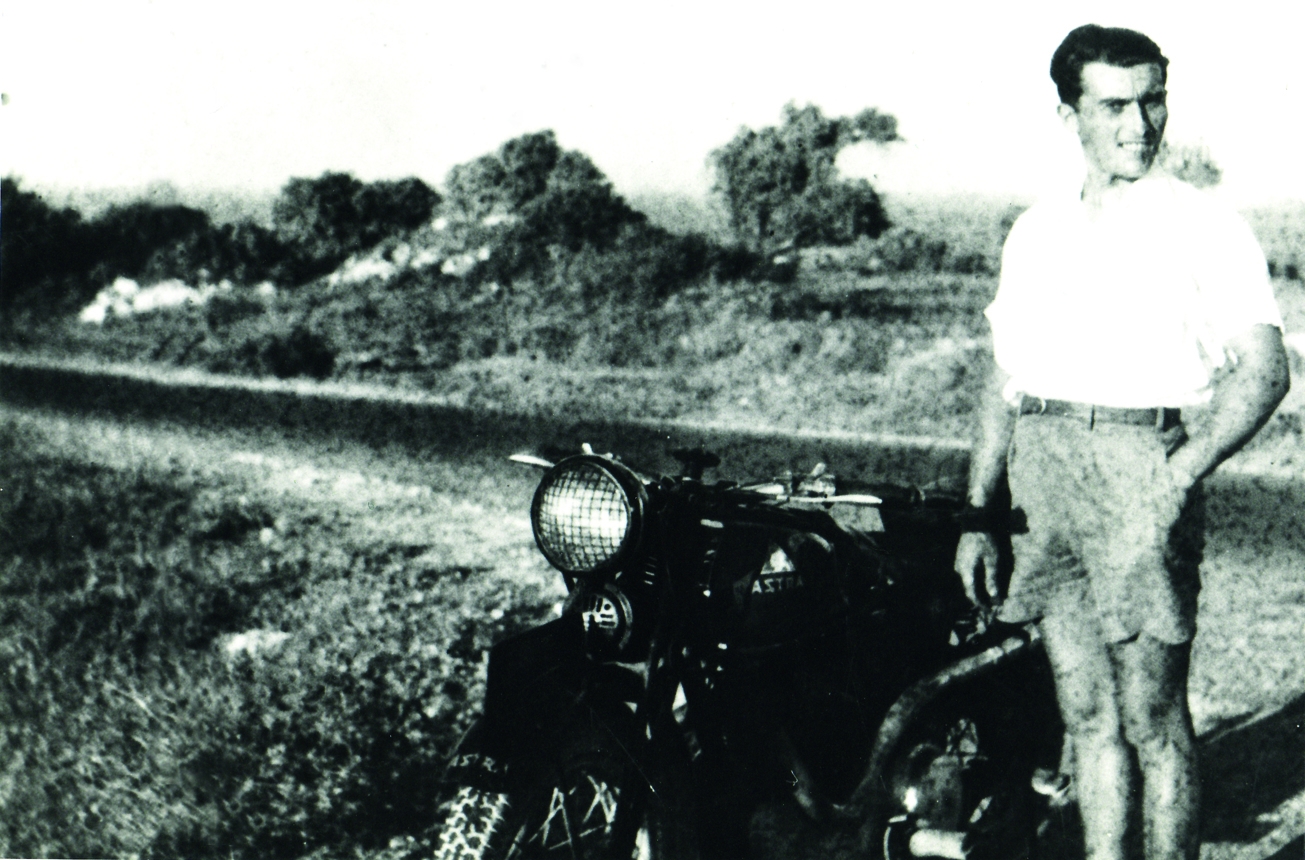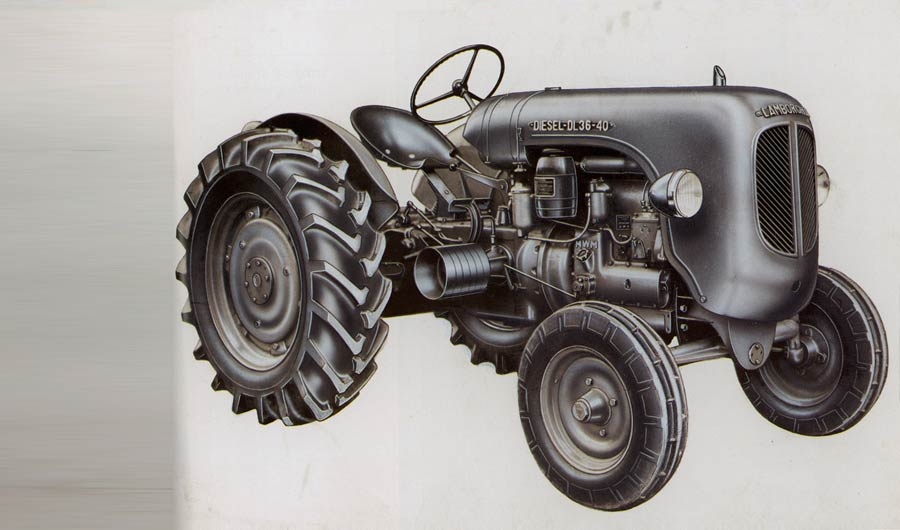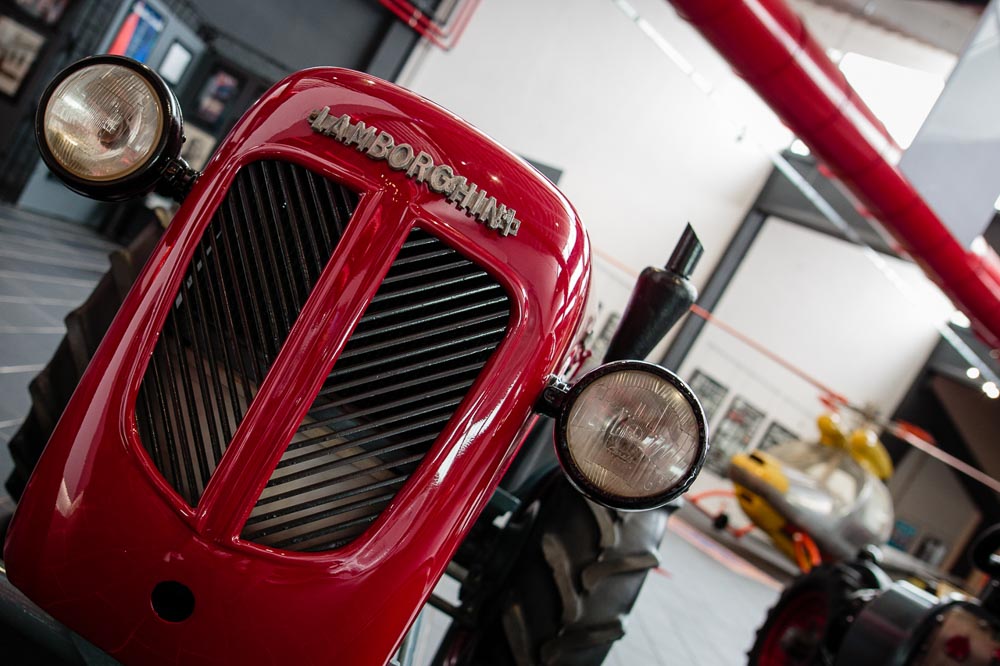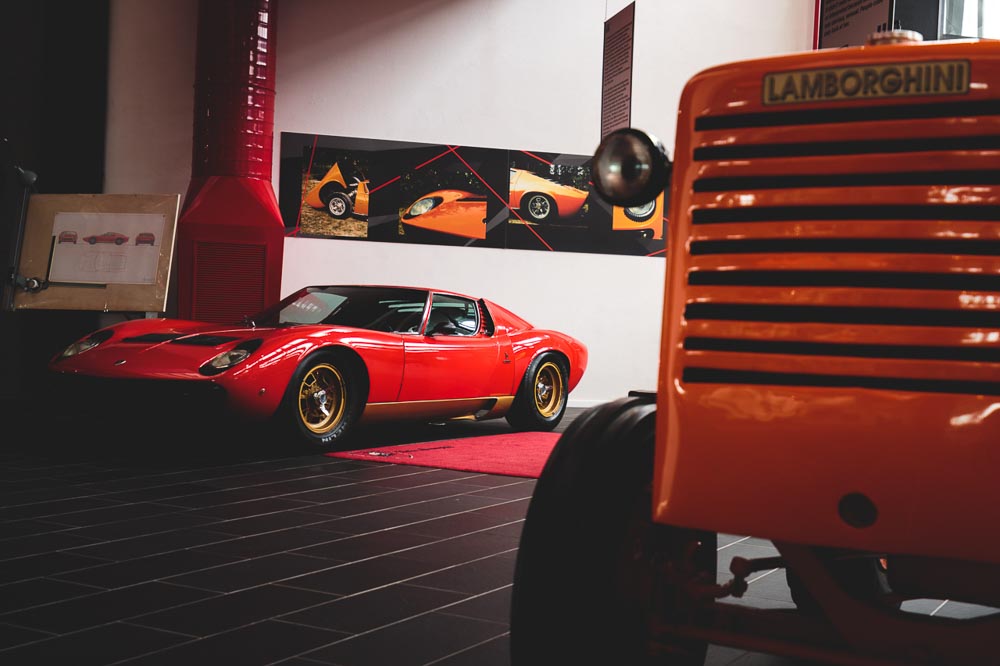History
The legendary life of Ferruccio Lamborghini through personal anecdotes handed down from family or narrated in the magazines of the time.
The Origins | 1916 – 1938
Ferruccio Lamborghini was born in Renazzo, in the Ferrara province, on April 28th, 1916. The eldest of five sons, he grew up in his family farm where his father tried passing him on the passion for land-work and agriculture.
But Ferruccio had a totally different take on his future, with a clear talent for engines and cars.
After primary school, Ferruccio attended the professional training institute, ‘Taddia Brothers’, an ever since melting pot of Centenese entrepreneurs. Once achieving the school license and despite the opposition of his father – who was willing to pass him over the management of the farm – he decided to start training in the workshop of a local master blacksmith, who shared with him the iron working and welding secrets.

Since he was very young, he was headstrong and stubborn, so he finally managed to get hired by cavalier Righi, owner of the most important workshop of Bologna. At that time the workshop was commissioned for the maintenance of the Army’s vehicles: this period, even though it was short, became of great importance for the experience and competences of Ferruccio.
After the Bolognese adventure, at 18 years old he opened a workshop in Renazzo with his lifelong friend Marino Filippini, who he had already worked with at Righi’s and who many years later would be employed in one of his factories.
Always animated by passion and bravery, when he could, he would buy an old used car or motorbike that, once fixed up, could easily be seen driven through the dusty country roads: these were carefree and intense years that left a lasting mark in the character and personality of Ferruccio.
This carefree atmosphere is though abruptly shattered by the outbreak of the war.
Ferruccio was sent to the isle of Rhodes, in the Aegean Sea, then Italian territory, and assigned to the ’50th Autoreparto Misto di Manovra’, reporting directly to the High Command Armed Forces of the island. Known as the ‘Autocentro’, this unit was responsible for the maintenance and repair of all military vehicles on the island.
The caporal autiere Ferruccio Lamborghini immediately realized the unique opportunity he had came across: to work with the most sophisticated tools of Italian and foreign mechanical industry.
Soon after Ferruccio was made head of the workshop department but it was first and foremost his extraordinary intuition that consistently brings him to the center of any situation and makes him one of the most popular around.
The bravery and talent of Ferruccio in the engines area lead him to popularity and to the total trust of the Commander, who also lended him his personal car to repair the brakes.
Island life continues, marked by the tragedy of war until September 8th, 1943, when all the staff of the ‘Autocentro’ runs away from the city. But Ferruccio couldn’t stay away from engines for too long and he returned to Rhodes in civilian clothes. After doing a series of odd jobs, he later opened a small workshop with the permission of the same Germans who preferred to take advantage of his mechanical skills rather than imprison him.
In 1946, a year after the war ended, he was free to return to Italy, but he was not alone. In Rhodes Ferruccio met Clelia, an Italian girl from Ferrara, who he madly fell in love with. At that time Ferruccio had clear ideas for his future: he wanted to get married and exploit the incredible opportunities, starting out in his Country, which was just wriggling away from war and where a new air of freedom and enterprise was inhaled.

Back to Italy, Ferruccio found a very particular situation: due to its geographical position away from the main roadways and infrastructure, the Centese area emerged from the conflict in ab better shape than many other areas, but, agriculture was in a crisis, after being for centuries the major source of income in the area. In this situation, there were some unique opportunities and Ferruccio was immediately caught up by the libertarian euphoria, the Italy-after-war redemption spirit, and by the simplified bureaucratic load required to begin industrial activities that boosted employment and decided to test its technical and mechanical knowledge (sometimes futuristic like the Diesel engine). He clearly foreseaw a new market for agriculture automation on large economies of scale.
At this time the market was dominated by Fiat, Landini, Motomeccanica, all of whom were still producing vehicles with combustion engines. Thus for several reasons there was plenty space for technological improvement.
At the end of 1947 Ferruccio Lamborghini decided to produce an economic yet powerful tractor dedicated to the peasants of the ‘Bassa’ with their small farms. He purchased all kinds of cheap surplus war equipment, improved the engine and the fuelling system and produced a very simple internal frame: the ‘Carioca’ tractor was born, introduced to the public on February 3rd, 1948, the day dedicated to Saint Biagio, patron saint of Cento town.
The degree of success was evident by the many farmers that admired, evaluated and bought the tractors.
Thus, he decided to expand production. His father came to his aid , and by giving the bank the farm as collateral, Ferruccio was granted a loan from the ‘Cassa di Risparmio di Cento’ and purchased a thousand Morris engines, 6-cylinder 3,500 cc gas powered, hired more workmen and started production of tractor L33, the evolution of the ‘Carioca’. In 1950, the annual production reached 200 pieces, the company employed 30 workers and the administration was carefully followed by Annita, who Ferruccio had married a few months earlier.
In 1951, he had to move to a larger structure: Ferruccio bought a ten-thousand square meters field, once a racetrack area and the first real production company was born: ‘Trattori Lamborghini’.
At the beginning of the 50s, the move from manufacturer to industrialist happened.
The number of employees increased with the growth of production, the name of Ferruccio was famous in the world by that time and the feelings in the company were cheerful and relaxed.
The sales network was born during these years. Initially Ferruccio tried finding the main customers, personally creating the distribution chain and meeting agents at the trade fairs.
The production unit required more and more space. The plant grows almost continuously: it was just before the economic boom and Ferruccio had once again hit the mark. He had a uncanny ability to understand what people wanted a minute before the competition did.
This is confirmed by the fact that, for some years, he had been producing tractors with Diesel engine and he soon obtained the license from MWM (Motoren Werke Mannheim) to produce those engines in Italy.
In 1952, the Italian government issues a new law, granting loans to farmers for the purchase of farm machinery, provided that it was produced domestically. Once again this demonstrated the great insight of Ferruccio. This law and the broker-ability of Ferruccio drove up production.
New products were projected and investment in innovation continued until, in the 60s, ‘Lamborghini Trattori’ reached nearly 400 employees and produced 25/30 units per day.

The 60s confirmed Lamborghini Trattori as a leader in the sector. The models launched on the market got great success: the name of Ferruccio was known worldwide and obtained important personal rewards.
In 1959, during a trip to the United States , Ferruccio Lamborghini visited a few companies that produced burners for domestic heating and immediately thought of the Italian situation. As a result of the economic boom and because home, with all its comforts, was the most common evocative dream at the time, he understood that the burners were a trend for the future, intended to replace coal-fired boilers for heating. Following accurate evaluation, he understood he could withstand competition in this field and embarked on the burner adventure.
He hired the best available technicians and in less than a year he built a new company in Pieve di Cento, ‘Lamborghini Bruciatori Condizionatori’.
But challenges were to continue. It was a period of intense change and evolution that pushed Ferruccio to start off his old passion for cars. It was the end of 1962 and all the staff was called together to announce the desire to start to build cars.
The selection of the project manager fell on the engineer Gian Paolo Dallara, a young designer with an excellent technical background, whom Ferruccio undertook a deep professional and personal relationship with; the design of the engine is assigned to Giotto Bizzarrini, who for four years had worked at Ferrari, and was involved in the development of models 250 GT 2+2 and GTO.
Once again, Ferruccio knew what he wanted: V12engine, four camshafts in the head, two valves per cylinder, six twin-choke carburetors and dry sump lubrication. As he already had done for other products, he hired the best technicians from the competition and started manufacturing a car that represented a dream for many car-lovers.
Ferruccio was willing to exhibit the new car at the Turin Motor Show in 1963. He purchased a field in Sant’Agata Bolognese and the technicians started working in a thereby workshop, while in the meantime the factory was built to become ‘Lamborghini Automobili’.
As the logo of the new company, he chose the Bull: warrior, stubborn, never tamed, just like his zodiac sign.
The company opened in Autumn 1963: at the same time, the 350 GT frame-engine was exhibited. However, surrounded by disbelief, Ferruccio didnt bother.
The car was first presented in Turin, then in Geneva, and soon after mass production started in one of the 11.000 square-meters warehouses with two assembly lines (one for engines, the other for assembly) and using modern machinery.
Once again Ferruccio was successful. Soon the company became one of the first Italian manufacturers of granturismo.
His product was excellent, the quality of cars was worldwide known, but the admiration was extended on Ferruccio himself: simple, charismatic, charming and skilled, he immediately established a very particular relationship with journalists and “colleagues” belonging to the automobile world.
In 1966, the P400 Miura was exhibited at the ‘Salone dell’Auto’ in Turin. A fast, endurance, extremely innovative granturismo impressed with a unique and unmistakable lifestyle.
The results were amazing. In its category, the Miura was many years ahead of competitors’ vehicle.
From all over the world, the most unlikely characters ask to purchase the car. Dozens of Miuras are ordered, cinema and music stars were competing to purchase one. All over the world, this name meant luxury and elegance. The Miura car is considered a piece of art and, indeed, exhibited at the MoMA in New York since 1968.


The end of the 60s marked the beginning of a new era inside the factories. For the first time, ‘Lamborghini Trattori’ was hit with a serious crisis that affected many sectors of the Italian economy. In the earlier years ‘Lamborghini Trattori’ carried out a radical transformation of the product that engaged most of the company from both a financial as organizational point of view. The number of employees doubled and a very large order from the Bolivian State was approved. But the political situation in the Southern American country suddenly changed following a coup-d’etat and the new government cancelled the order. As a result, in 1970, there were 5.000 tractors ready and held still on the factory ground.
The company was strongly marked by the presence of the trade unions and by strikes: Ferruccio became very disoriented.
In the Spring of 1971, the crisis seemed to slowly recede, but it came at a high cost: the buildings, and only the buildings, were sold to FIAT, which was interested in gaining an opening in an area such as Cento, already rich in highly specialized manpower.
Each employee was given a choice to either go to FIAT or to follow Ferruccio in the new company located in Pieve. In fact, in 1970 ‘Lamborghini Burners’ was transferred to Dosso, where in the meantime a modern and large facility was completed, designed to accommodate the increased production of air conditioners, boilers and burners: ‘Lamborghini Calor’.
With the newfound liquidity gained by the sale of the tractors originally made for Bolivia, without carrying the high management costs and thanks to the support of the loyal workers, Ferruccio seemed reborn. However he was signed by the years of crisis and in 1973 he decided to sell ‘Trattori’ to Same, which he had handed over management a year earlier.
The company he handed over was healthy, modern, with highly skilled labor force.
The year before, in 1972, he took another drastic decision: he sold 51% shares of ‘Lamborghini Automobili’. After excellent years, signed by the production of the Countach car, Lamborghini realizes that the situation had permanently changed: the first signals of the ‘energy crisis’, austerity and social pressure lead to serious consequences and Ferruccio was no longer in line with the industrial world he was surrounded by.
After deciding to separate from his companies, Ferruccio started looking for an ideal space, far away from the noise of the industrial world, to rediscover the relationship he had with the land that had never abandoned him.
He purchased a land near Lake Trasimeno (La Fiorita) and in 1974 he moved.
Engaged with great effort in working on the estate, he turned an old cottage covered with holly oak trees into one of the most modern agricultural estates of Europe: he transformed the farmhouse, bought more land and finally called one of the most experienced winemakers in Italy and created an absolutely innovative winery for those years.
Initially, Ferruccio moved to ‘La Fiorita’ to relax and to go hunting. But given his continuous entrepreneur tendency, soon he turned that land into a renomated farm, tennis camps, swimming pools and golf camps.
There, Ferruccio lived his last years; he died in 1993, surrounded by friends who daily visited him to remember the past days together and also project the future.